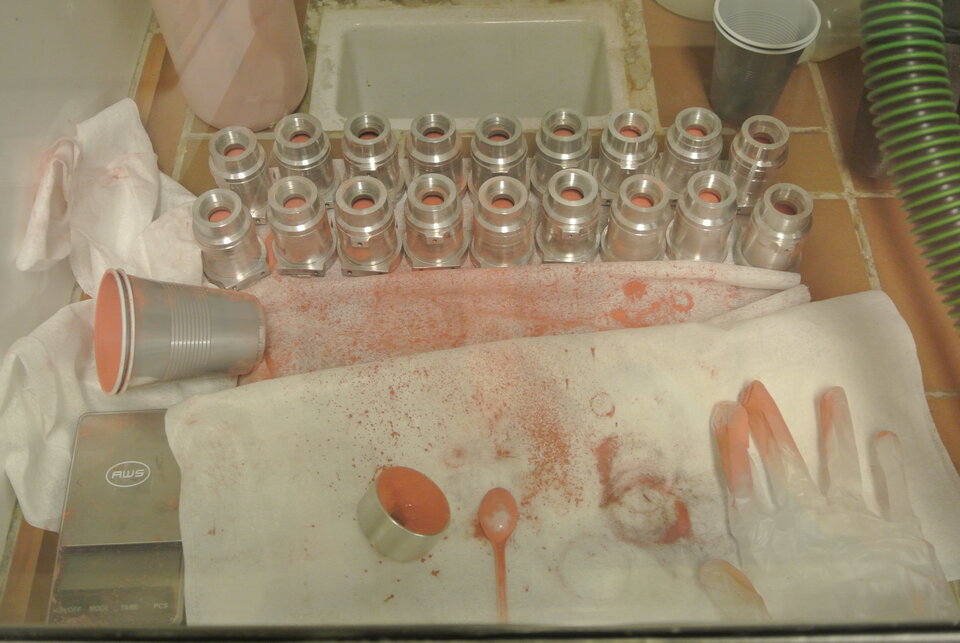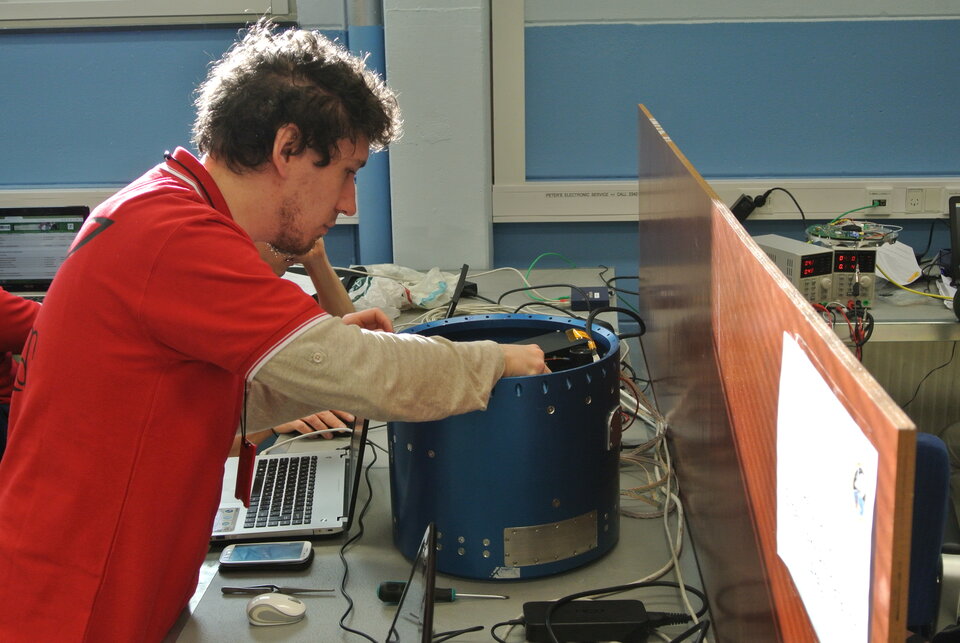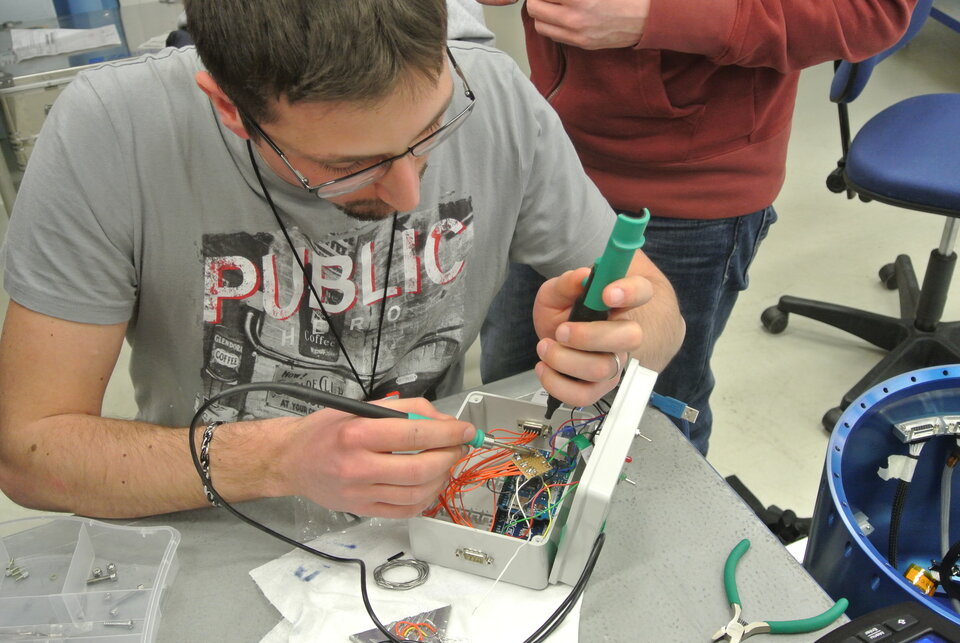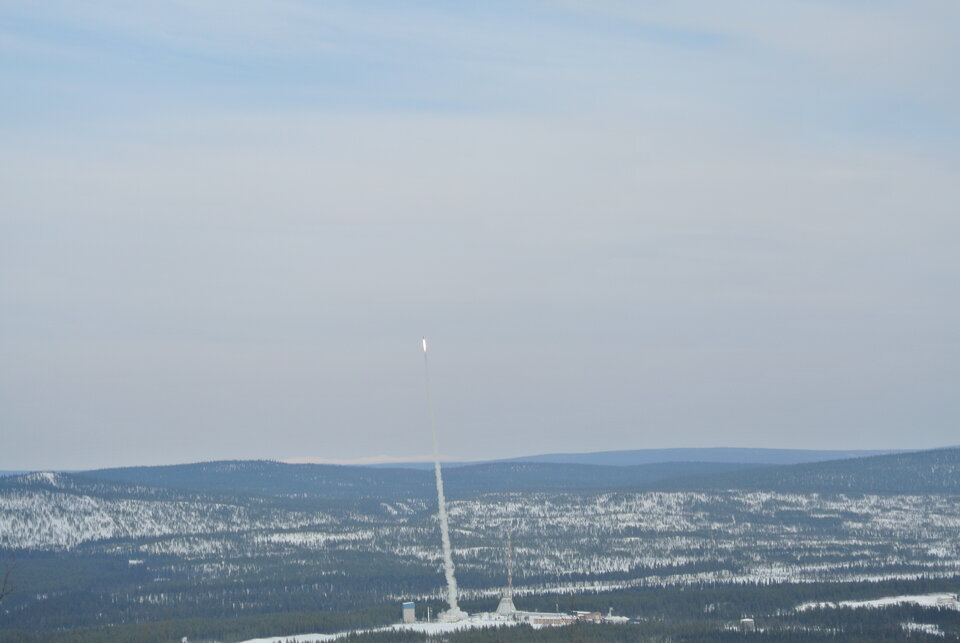University student experiments take to the skies
It was up, up and away for seven teams of university students last week when the REXUS 17 and 18 sounding rockets took to the sky. The teams’ experiments soared to the top of the Mesosphere, returning data that will now be analysed.
The rockets were launched from the Esrange Space Center about 40 km east of Kiruna, Sweden, where the student teams have been working since 9 March to prepare their experiments for launch.
Four of the teams had been chosen by the Swedish National Space Board (SNSB) and ESA. The other three were chosen by the German Space Agency (DLR). All were selected in December 2013.
Each of the rockets was just below 6 meters long with a diameter of 35.6 centimetres. Powered by an Orion motor with 290kg of solid propellant, REXUS 17 was successfully launched on the 17 March at 09:15 UTC and reached its target altitude of 87km. REXUS 18 followed the next day at 13:13 UTC, reaching its target of 81km in altitude.

REXUS 17 carried three SNSB and ESA selected student experiments.
SCRAP (Royal Institute of Technology, Sweden) ejected two FFU’s (free flying units) from the rocket. After a set time each was programmed to eject a cloud of copper particles. EISCAT, a scatter radar in Tromsø, Norway, was transmitting radio waves where the clouds where expected to be located with the aim of testing theories of electron density fluctuations in dusty plasmas. The data must now be analysed to determine whether the experiment was successful.
"Taking part in this programme is a once in a life time opportunity, we learned far beyond what is taught in the lecture halls. We learned to work as a team, we got to know the industry and we became friends with other students from all over Europe and had the unique chance to launch our first rockets together. It has been a great journey!” said a spokesperson from the SCRAP team.

WUSAT-SOLSPEC (University of Warwick, UK) was ejected from the rocket’s nosecone and established radio contact with the ground 15 seconds later. Communicating via an in-house developed antenna, the data link lasted for minutes during which time WUSAT-SOLSPEC gathered data from the solar spectrum to determine the atmospheric composition of elements such as sodium and molecular oxygen. The quality of the data is yet to be evaluated.
“The REXUS-BEXUS programme provided an opportunity to get involved in a space project. The range of engineering/design challenges involved tested all disciplines within the team. We learnt a great deal from our project as well as from the interactions with the experts and other teams we met throughout the process. The common atmosphere at all events was one of motivation to achieve something special with this unique opportunity.” said a spokesperson from the WUSAT-SOLSPEC team.

REM-RED (Budapest University of Technology and Economics, Hungary) was a follow-up of the previous experiments CoCoRAD and TECHDOSE that flew on the high-altitude balloon missions BEXUS 12 and 14. The experiment made measurements of the cosmic radiation field using Geiger-Müller tubes. They will now use the data to improve their model and understanding of cosmic rays in relation to altitude.
“It can't be described how you feel in the very last moments before the launch! You realise immediately that all the hard work of the last year is now concentrated into a single, very last moment! This is amazing, memorable forever and shows that you can do anything if you believe in yourself and your capabilities!” said a spokesperson from the REM-RED team.

REXUS 18 carried just one SNSB and ESA selected experiment, PHOS (University of Pisa, Italy). It was designed to research the possibility of using PHP’s (pulsating heat pipes) of larger diameter as a means of thermal control for future spacecraft. The experiment operated nominally throughout the flight and all the technical objectives could be met. However, due to a malfunction of the rockets de-spin mechanism, the expected gravity conditions were not achieved, and the experiment could not reach its scientific objective.
Even so, the team believes it was highly valuable. “The REXUS programme has been an amazing experience, a way to become aware of our capabilities and to understand that together we can reach space. It gave us the possibility to understand who we are as professionals and to create a multidisciplinary environment in which we could improve our knowledge,” said a spokesperson from PHOS.
All three German experiments called ACTOR (Aerogel Cells Tested on REXUS), LICOD (Light Induced Compression of Dust clouds), and SMARD (Shape Memory Alloy Reusable Deployment Mechanism) met their technical objectives. Two of them also additionally met most of their scientific, non-gravity-dependent ones.
The next series of experiments in the REXUS/BEXUS programme were already chosen in December 2014. The next call for proposals will be issued in mid-June 2015, with the deadline set for mid-October.
Notes for editors:
The REXUS/BEXUS programme is realised under a bilateral Agency Agreement between the German Aerospace Center (DLR) and the Swedish National Space Board (SNSB). The Swedish share of the payload has been made available to students from other European countries through the collaboration with the European Space Agency (ESA).
EuroLaunch, the cooperation between the Esrange Space Center of SSC and the Mobile Rocket Base (MORABA) of DLR, is responsible for the campaign management and operations of the launch vehicles. Experts from DLR, SSC, ZARM and ESA provide technical support to the student teams throughout the project.





